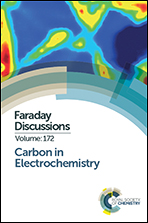Electron transport in all-carbon molecular electronic devices
Abstract
Carbon has always been an important electrode material for electrochemical applications, and the relatively recent development of carbon nanotubes and graphene as electrodes has significantly increased interest in the field. Carbon solids, both sp2 and sp3 hybridized, are unique in their combination of electronic conductivity and the ability to form strong bonds to a variety of other elements and molecules. The Faraday Discussion included broad concepts and applications of carbon materials in electrochemistry, including analysis, energy storage, materials science, and solid-state electronics. This introductory paper describes some of the special properties of carbon materials useful in electrochemistry, with particular illustrations in the realm of molecular electronics. The strong bond between sp2 conducting carbon and aromatic organic molecules enables not only strong electronic interactions across the interface between the two materials, but also provides sufficient stability for practical applications. The last section of the paper discusses several factors which affect the electron transfer kinetics at highly ordered pyrolytic graphite, some of which are currently controversial. These issues bear on the general question of how the structure and electronic properties of the carbon electrode material control its utility in electrochemistry and electron transport, which are the core principles of electrochemistry using carbon electrodes.
- This article is part of the themed collections: Carbon in Electrochemistry and The Spiers Memorial Lectures

 Please wait while we load your content...
Please wait while we load your content...